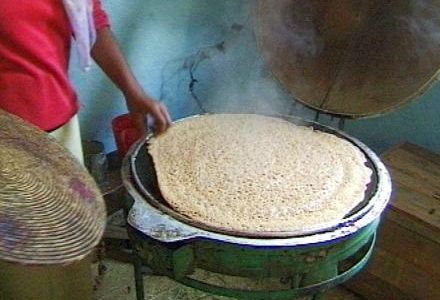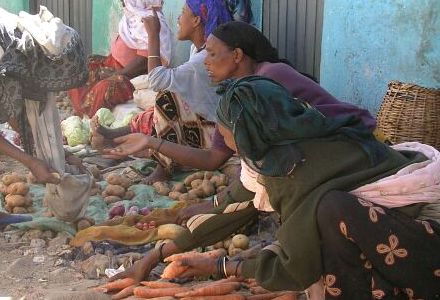 |
A culinary Journey to Ethiopia > Around an injera
Godjo is the name given to the humblest house, that of the farmer. To the question "What is a farmer?", the sage replies: "The farmer is the servant of the products of the earth. He sighs after the rain and hopes to obtain water when his fields are sown. His work is for food. He beautifies the soil; he is the physician of the land, the consoler of the countryside. He stays on the fields with the wild animals, patiently enduring the dew. He is good to travelers. He feeds the birds; he is the founder of everything, the chief of all merchants."
Abba Michael - Ethiopian sage, from the "Philosophers' Book" completed between 1510 and 1522.
The cradle of one of the world's oldest civilizations, Ethiopia (country of the burned faces in Greek), alone sums up the dark continent, known to the pharaohs and mentioned in the Old Testament. It's the land of the Blue Nile that stretches over 800 km and pours out millions of gallons of water near Bahar Dar, creating spectacular rainbows above the "smoking" falls.
Like its landscapes, ethnic groups and dialects, Ethiopia's cooking is diverse, whether you're speaking about Amharic, Tigrigna or Oramigna, whether you live in the Kwolla, the "hot lands" zone that receives abundant rainfall, often unhealthy and covered in thick forests that are difficult to cross or arid steps; woinadaga, with its subtropical climate, the most heavily populated and cultivated region; or the daiga, the "cold lands" zone, home to livestock and grain production at elevations above 2500 m.
Step up to the mesob, the traditional circular table of colored wicker. Here, no utensils are used. You eat with your hands: your right hand, specifically.... the left hand is reserved for something else.
In Ethiopian restaurants, you can opt for the fesek menu (including meat), or the tsom menu (vegetarian).

One of the most common dishes is Wot, a spicy meat or vegetable stew, usually served with injera, a flat bread made from teff flour that is dipped into the stew to soak up the juices; when bent, it serves as a spoon to pick up pieces from the thick sauce, since here one eats with the hands.
Wot is prepared in various ways, depending on whether you use beef, mutton or chicken, or more traditionally, fish. Vegetarians have their version made with lentils and chick peas. Chicken wot usually includes hard-boiled eggs. But whatever the recipe, there are also red onions and berbere.
Berbere is the basic seasoning, a fairly hot mixture of dried chilis, spices and salt. It comes in two forms: powdered (made from the three aforementioned ingredients); and as paste (including red onion, wine and ginger).

Injera is a staple: Ethiopian bread that resembles a large crepe. It is usually made from local flour: white, red or black teff, or with a tiny grain such as fonio (acha) from the west; among the Oromos, the bread is made with corn or millet flour.
Ethiopia produces its own wines: Dukam and Gouder for reds; Axumite, a sweet red wine; and Crystals for white. However the best is Tel, a honey wine that is found in various parts of the country. There is also Tela, the local beer, and Katikala, a liqueur.
I almost forgot about the coffee! Did you know that coffee plants originated in Ethiopia? In every household, it's the duty of the head of the family to buy the beans and roast them himself. He buys pure Moka Djimmah that grows on the high plateaus above 1800 m in altitude.


Did you know that coffee plants originated in Ethiopia?
Photo 1: roasting coffee beans
photo 2: cooking injera the traditional way (Oxfam UK);
photo 3: cooking injera the modern way
photo 4: Harar market (Goshen College, Indiana).

-

 Recipes
Recipes
-

 Products
Products
-

 Entertaining
Entertaining
-

 Chefs
Chefs
-

 Hints & Tips
Hints & Tips
-

 Glossaries
Glossaries








